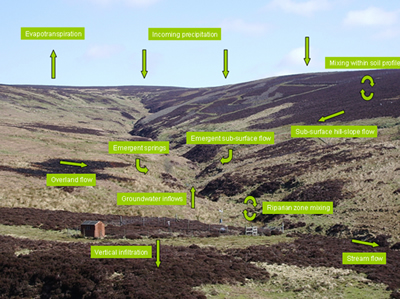
River flows are generated by water that has fallen as precipitation on the land and then been transported over time via different flow pathways to the river. During its transport the water may be mixed and stored within the soil or deeper geological strata, and may follow many potential flow pathways to reach the river. The flow pathways vary over space and also with time, in response to varying precipitation inputs. As it is stored and transported the water interacts chemically and biologically with constituents of the soil and geology leading to the removal of soluble and particulate materials. The chemical characteristics and age of the water as it reaches the river are highly dependent on the transport pathways and mixing processes that have occurred.
Our research focuses on understanding how water is transported from the land to rivers, and on assessing the consequences of this for catchment management. It adopts a learning framework methodology to study transport processes. This approach integrates monitoring of systems with model development, analysis and experimentation, in an iterative procedure.
Find out more about our work on:
- Using solute tracers in modelling
- Process conceptualization and prediction
- Catchment water quality modelling
- High resolution monitoring
- National scale risk assessment
|
Updated: 23 Jan 2024, Content by: MC
|

